steering wheel Hyundai Getz 2009 Owner's Manual - RHD (UK, Australia)
[x] Cancel search | Manufacturer: HYUNDAI, Model Year: 2009, Model line: Getz, Model: Hyundai Getz 2009Pages: 191, PDF Size: 6.3 MB
Page 39 of 191
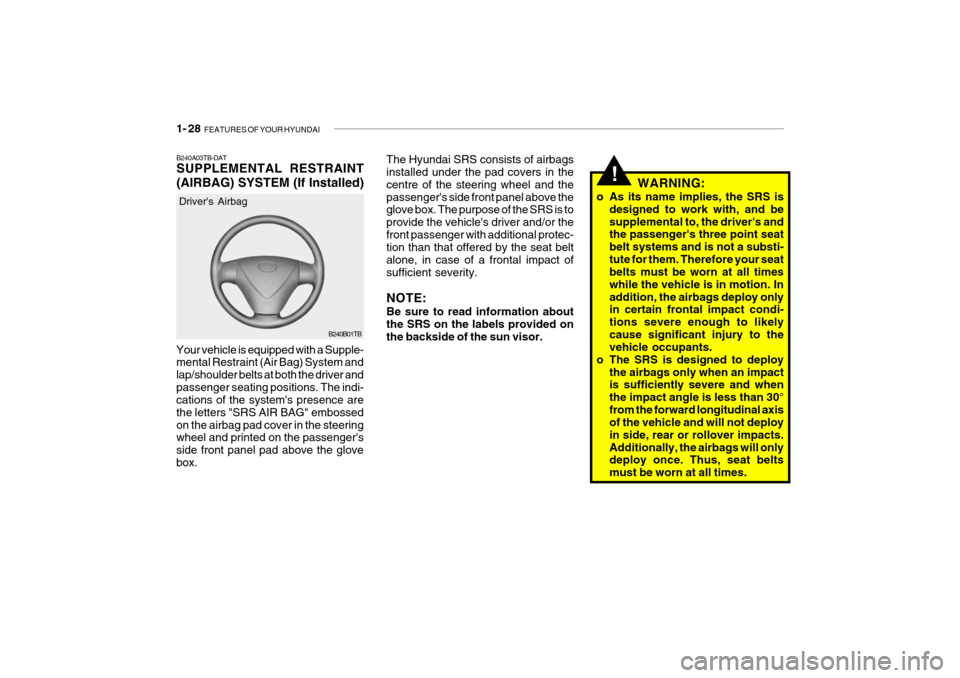
1- 28 FEATURES OF YOUR HYUNDAI
B240B01TB
Driver's Airbag
Your vehicle is equipped with a Supple- mental Restraint (Air Bag) System and lap/shoulder belts at both the driver andpassenger seating positions. The indi- cations of the system's presence are the letters "SRS AIR BAG" embossedon the airbag pad cover in the steering wheel and printed on the passenger's side front panel pad above the glovebox. B240A03TB-DAT SUPPLEMENTAL RESTRAINT (AIRBAG) SYSTEM (If Installed)
WARNING:
o As its name implies, the SRS is designed to work with, and be supplemental to, the driver's and the passenger's three point seat belt systems and is not a substi-tute for them. Therefore your seat belts must be worn at all times while the vehicle is in motion. Inaddition, the airbags deploy only in certain frontal impact condi- tions severe enough to likelycause significant injury to the vehicle occupants.
o The SRS is designed to deploy the airbags only when an impactis sufficiently severe and when the impact angle is less than 30°from the forward longitudinal axis of the vehicle and will not deploy in side, rear or rollover impacts.Additionally, the airbags will only deploy once. Thus, seat belts must be worn at all times.
The Hyundai SRS consists of airbags installed under the pad covers in the centre of the steering wheel and thepassenger's side front panel above the glove box. The purpose of the SRS is to provide the vehicle's driver and/or thefront passenger with additional protec- tion than that offered by the seat belt alone, in case of a frontal impact ofsufficient severity. NOTE: Be sure to read information about the SRS on the labels provided on the backside of the sun visor.
!
Page 41 of 191
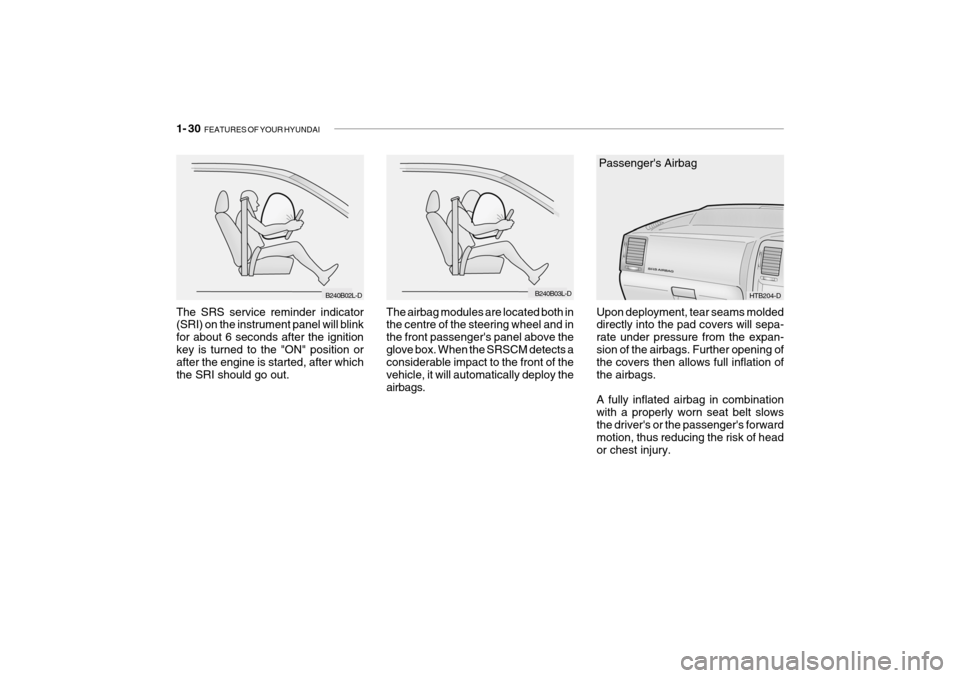
1- 30 FEATURES OF YOUR HYUNDAI
The SRS service reminder indicator (SRI) on the instrument panel will blink for about 6 seconds after the ignitionkey is turned to the "ON" position or after the engine is started, after which the SRI should go out. The airbag modules are located both in the centre of the steering wheel and in the front passenger's panel above theglove box. When the SRSCM detects a considerable impact to the front of the vehicle, it will automatically deploy theairbags.
Passenger's Airbag
Upon deployment, tear seams molded directly into the pad covers will sepa- rate under pressure from the expan-sion of the airbags. Further opening of the covers then allows full inflation of the airbags. A fully inflated airbag in combination with a properly worn seat belt slowsthe driver's or the passenger's forward motion, thus reducing the risk of head or chest injury. HTB204-D
B240B02L-DB240B03L-D
Page 43 of 191
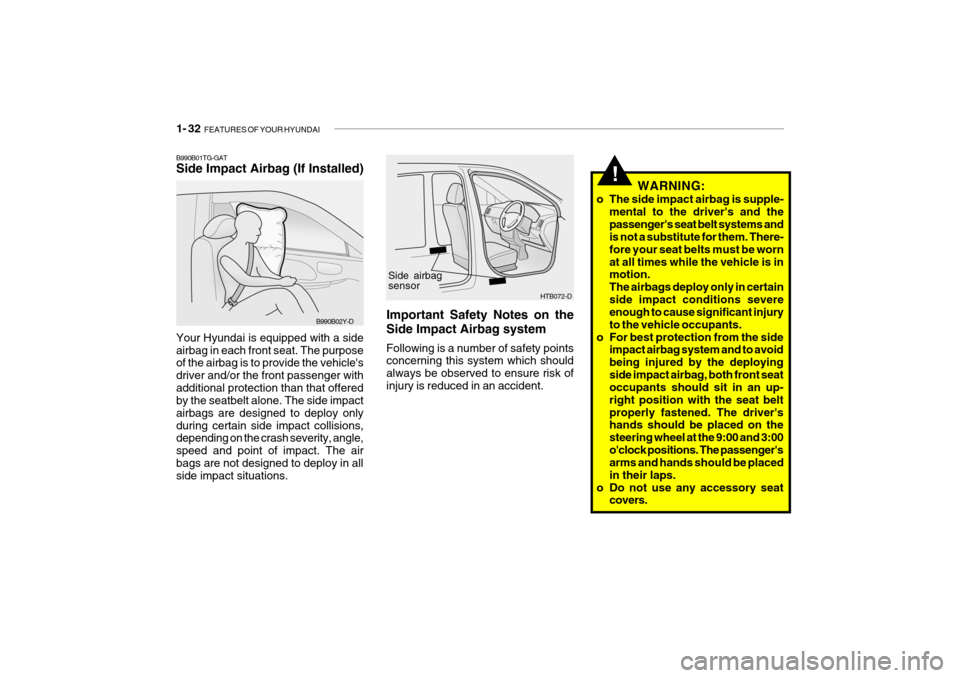
1- 32 FEATURES OF YOUR HYUNDAI
!
B990B01TG-GAT Side Impact Airbag (If Installed) Your Hyundai is equipped with a side airbag in each front seat. The purpose of the airbag is to provide the vehicle's driver and/or the front passenger withadditional protection than that offered by the seatbelt alone. The side impact airbags are designed to deploy onlyduring certain side impact collisions, depending on the crash severity, angle, speed and point of impact. The airbags are not designed to deploy in all side impact situations.
B990B02Y-D
HTB072-D
Side airbag sensor
Important Safety Notes on the Side Impact Airbag system Following is a number of safety points concerning this system which should always be observed to ensure risk ofinjury is reduced in an accident. WARNING:
o The side impact airbag is supple- mental to the driver's and thepassenger's seat belt systems and is not a substitute for them. There- fore your seat belts must be wornat all times while the vehicle is in motion. The airbags deploy only in certainside impact conditions severe enough to cause significant injury to the vehicle occupants.
o For best protection from the side impact airbag system and to avoidbeing injured by the deployingside impact airbag, both front seat occupants should sit in an up- right position with the seat beltproperly fastened. The driver's hands should be placed on the steering wheel at the 9:00 and 3:00o'clock positions. The passenger's arms and hands should be placed in their laps.
o Do not use any accessory seat covers.
Page 44 of 191
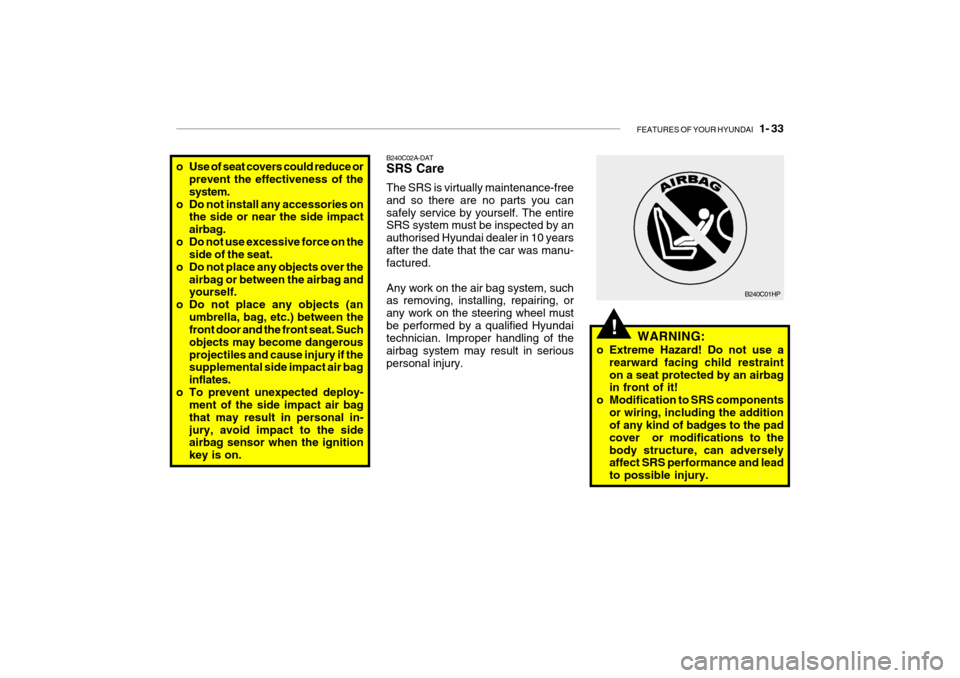
FEATURES OF YOUR HYUNDAI 1- 33
!WARNING:
o Extreme Hazard! Do not use a rearward facing child restraint on a seat protected by an airbag in front of it!
o Modification to SRS components or wiring, including the additionof any kind of badges to the pad cover or modifications to thebody structure, can adversely affect SRS performance and lead to possible injury.
B240C01HP
B240C02A-DAT SRS Care The SRS is virtually maintenance-free and so there are no parts you cansafely service by yourself. The entire SRS system must be inspected by an authorised Hyundai dealer in 10 yearsafter the date that the car was manu- factured. Any work on the air bag system, such as removing, installing, repairing, or any work on the steering wheel mustbe performed by a qualified Hyundai technician. Improper handling of the airbag system may result in seriouspersonal injury.
o Use of seat covers could reduce or
prevent the effectiveness of thesystem.
o Do not install any accessories on the side or near the side impactairbag.
o Do not use excessive force on the side of the seat.
o Do not place any objects over the
airbag or between the airbag and yourself.
o Do not place any objects (an
umbrella, bag, etc.) between thefront door and the front seat. Such objects may become dangerousprojectiles and cause injury if the supplemental side impact air bag inflates.
o To prevent unexpected deploy- ment of the side impact air bagthat may result in personal in-jury, avoid impact to the side airbag sensor when the ignition key is on.
Page 45 of 191
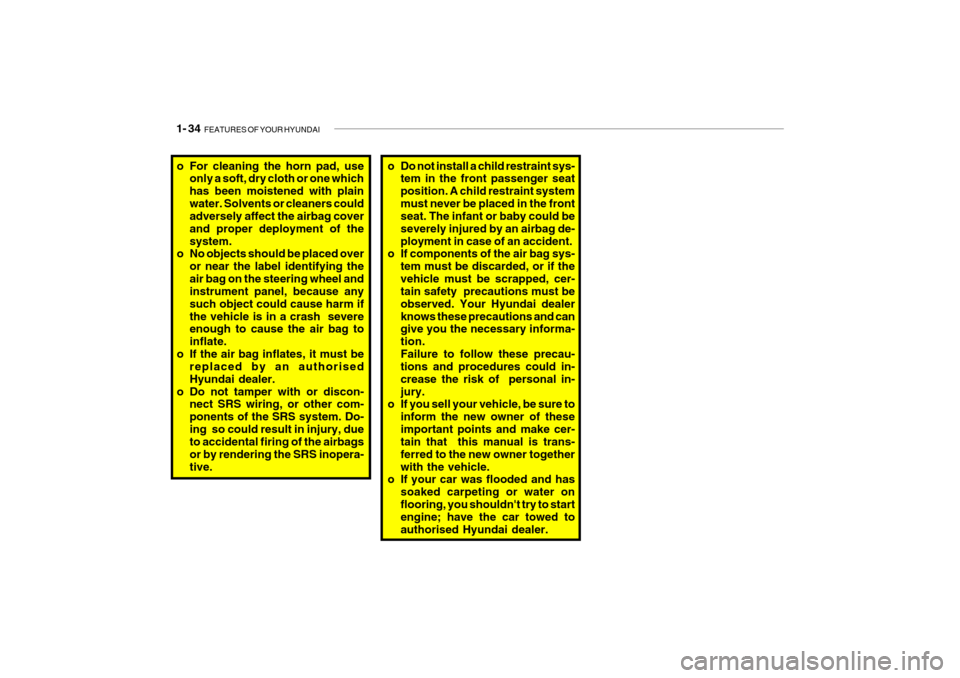
1- 34 FEATURES OF YOUR HYUNDAI
o Do not install a child restraint sys-
tem in the front passenger seat position. A child restraint systemmust never be placed in the front seat. The infant or baby could be severely injured by an airbag de-ployment in case of an accident.
o If components of the air bag sys-
tem must be discarded, or if thevehicle must be scrapped, cer- tain safety precautions must be observed. Your Hyundai dealerknows these precautions and can give you the necessary informa- tion.Failure to follow these precau- tions and procedures could in- crease the risk of personal in-jury.
o If you sell your vehicle, be sure to
inform the new owner of theseimportant points and make cer- tain that this manual is trans- ferred to the new owner togetherwith the vehicle.
o If your car was flooded and has
soaked carpeting or water onflooring, you shouldn't try to start engine; have the car towed to authorised Hyundai dealer.o For cleaning the horn pad, useonly a soft, dry cloth or one which has been moistened with plainwater. Solvents or cleaners could adversely affect the airbag cover and proper deployment of thesystem.
o No objects should be placed over
or near the label identifying theair bag on the steering wheel and instrument panel, because any such object could cause harm ifthe vehicle is in a crash severe enough to cause the air bag to inflate.
o If the air bag inflates, it must be replaced by an authorisedHyundai dealer.
o Do not tamper with or discon- nect SRS wiring, or other com-ponents of the SRS system. Do-ing so could result in injury, due to accidental firing of the airbags or by rendering the SRS inopera-tive.
Page 80 of 191
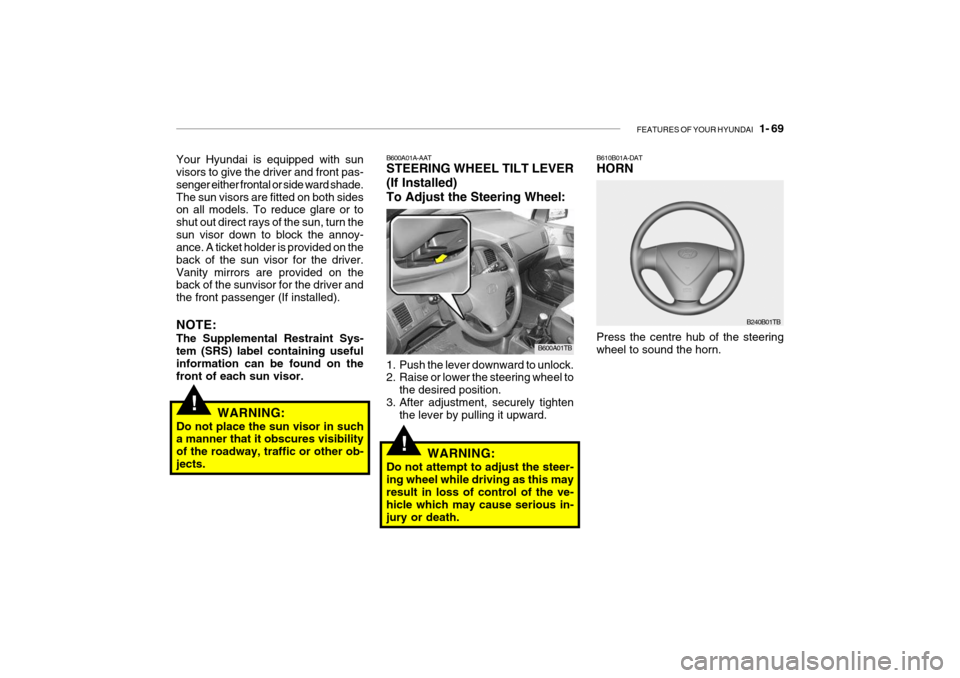
FEATURES OF YOUR HYUNDAI 1- 69
!
B610B01A-DAT HORN
Press the centre hub of the steering wheel to sound the horn. B240B01TBB600A01A-AAT STEERING WHEEL TILT LEVER (If Installed)To Adjust the Steering Wheel:
1. Push the lever downward to unlock.
2. Raise or lower the steering wheel to
the desired position.
3. After adjustment, securely tighten the lever by pulling it upward.
WARNING:
Do not attempt to adjust the steer- ing wheel while driving as this mayresult in loss of control of the ve- hicle which may cause serious in- jury or death.
!
Your Hyundai is equipped with sun visors to give the driver and front pas- senger either frontal or side ward shade.The sun visors are fitted on both sides on all models. To reduce glare or to shut out direct rays of the sun, turn thesun visor down to block the annoy- ance. A ticket holder is provided on the back of the sun visor for the driver.Vanity mirrors are provided on the back of the sunvisor for the driver and the front passenger (If installed). NOTE: The Supplemental Restraint Sys- tem (SRS) label containing useful information can be found on the front of each sun visor.
WARNING:
Do not place the sun visor in such a manner that it obscures visibility of the roadway, traffic or other ob-jects.
B600A01TB
Page 81 of 191
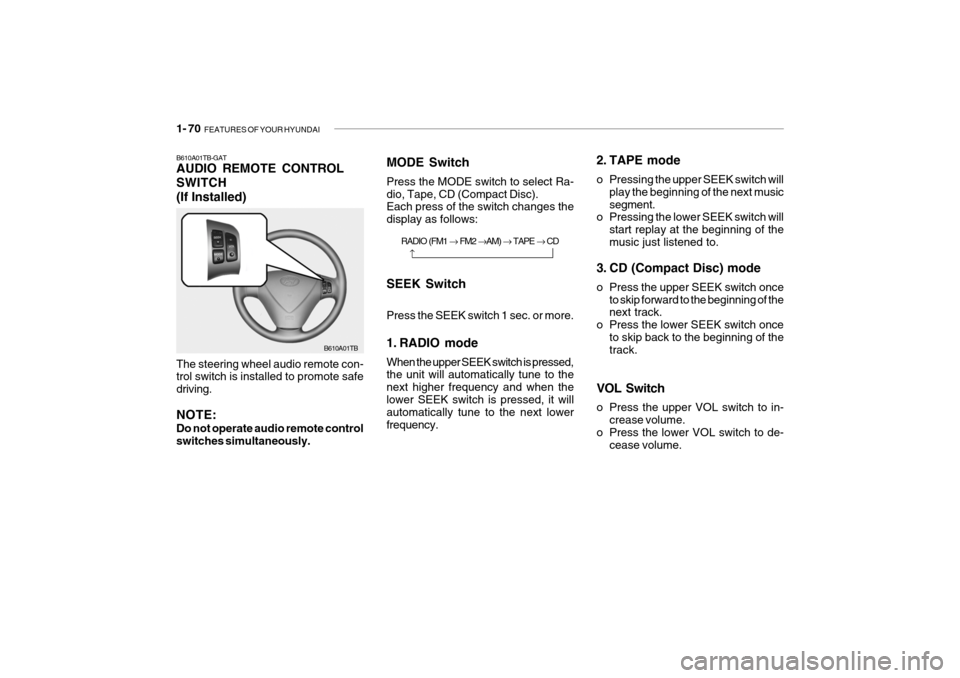
1- 70 FEATURES OF YOUR HYUNDAI
Press the SEEK switch 1 sec. or more.
1. RADIO mode When the upper SEEK switch is pressed, the unit will automatically tune to the next higher frequency and when thelower SEEK switch is pressed, it will automatically tune to the next lower frequency.
MODE Switch Press the MODE switch to select Ra- dio, Tape, CD (Compact Disc). Each press of the switch changes the display as follows:
RADIO (FM1 � FM2 �AM) � TAPE � CD
SEEK Switch
B610A01TB-GAT AUDIO REMOTE CONTROL SWITCH(If Installed) The steering wheel audio remote con- trol switch is installed to promote safe driving. NOTE: Do not operate audio remote control switches simultaneously. B610A01TB
�
2. TAPE mode
o Pressing the upper SEEK switch will
play the beginning of the next music segment.
o Pressing the lower SEEK switch will
start replay at the beginning of themusic just listened to.
3. CD (Compact Disc) mode
o Press the upper SEEK switch once to skip forward to the beginning of the next track.
o Press the lower SEEK switch once to skip back to the beginning of thetrack.
VOL Switch
o Press the upper VOL switch to in- crease volume.
o Press the lower VOL switch to de-
cease volume.
Page 99 of 191
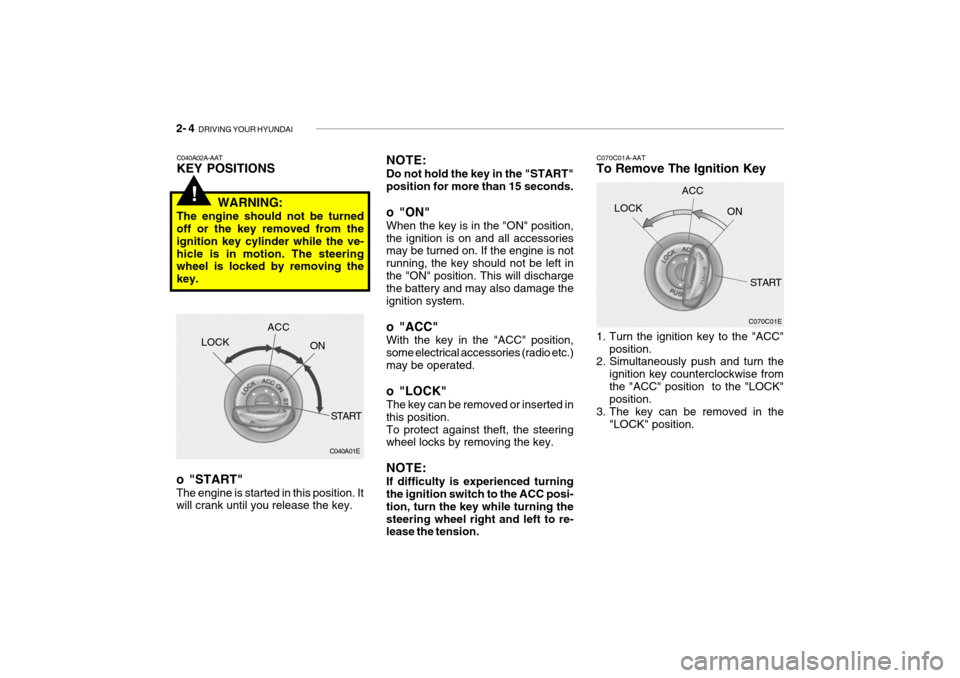
2- 4 DRIVING YOUR HYUNDAI
C070C01E
C070C01A-AAT
To Remove The Ignition Key
1. Turn the ignition key to the "ACC"
position.
2. Simultaneously push and turn the
ignition key counterclockwise from the "ACC" position to the "LOCK" position.
3. The key can be removed in the "LOCK" position.LOCK
ACC
ON
START
NOTE: Do not hold the key in the "START" position for more than 15 seconds.
o "ON" When the key is in the "ON" position, the ignition is on and all accessories may be turned on. If the engine is not running, the key should not be left inthe "ON" position. This will discharge the battery and may also damage the ignition system.
o "ACC" With the key in the "ACC" position, some electrical accessories (radio etc.)may be operated.
o "LOCK" The key can be removed or inserted in this position.To protect against theft, the steering wheel locks by removing the key. NOTE: If difficulty is experienced turning the ignition switch to the ACC posi- tion, turn the key while turning thesteering wheel right and left to re- lease the tension.
!
C040A02A-AAT KEY POSITIONS
WARNING:
The engine should not be turned off or the key removed from the ignition key cylinder while the ve-hicle is in motion. The steering wheel is locked by removing the key.
C040A01E
LOCK
ACC
ON
START
o "START" The engine is started in this position. It will crank until you release the key.
Page 102 of 191

DRIVING YOUR HYUNDAI 2- 7
!
o Exercise extreme caution when driv-
ing on a slippery surface. Be espe- cially careful when braking, acceler-ating or shifting gears. On a slippery surface, an abrupt change in ve- hicle speed can cause the drivewheels to lose traction and the ve- hicle to go out of control.
C070D02O-AAT Good Driving Practices
o Never take the car out of gear and
coast down a hill. This is extremely hazardous. Always leave the car in gear.
o Don't "ride" the brakes. This can
cause them to overheat and mal-function. Instead, when you are driv- ing down a long hill, slow down andshift to a lower gear. When you do this, engine braking will help slow the car.
o Slow down before shifting to a lower gear. This will help avoid over-rev-ving the engine, which can causedamage.
o Slow down when you encounter
cross winds. This gives you muchbetter control of your car.
o Be sure the car is completely stopped
before you attempt to shift into re-verse. The transaxle can be dam- aged if you do not. To shift into reverse, depress the clutch, movethe shift lever to neutral, wait three seconds, then shift to the reverse position. HTB185-D
C090A01A-GAT AUTOMATIC TRANSAXLE
The highly efficient Hyundai automatic transaxle has four forward speeds andone reverse speed. It has a conven- tional shift pattern as shown in the illustration. At night, with the first posi-tion of the multi-function switch, the appropriate symbol on the shift pattern indicator will be illuminated accordingto the range selected. CAUTION:
Never shift into "R" or "P" position while the vehicle is moving.
!
WARNING:
o Avoid high cornering speeds.
o Do not make quick steering wheel movements, such as sharp lane changes or fast, sharp turns.
o Always wear your seat belts.
In a collision crash, an unbeltedperson is significantly more likely to die than a person wearing a seatbelt.
o The risk of rollover is greatly in-
creased if you lose control of yourvehicle at highway speeds.
o Loss of control often occurs if two
or more wheels drop off the road-way and the driver oversteers to reenter the roadway.
o In the event your vehicle leaves the roadway, do not steer sharply. In-stead, slow down before pullingback into the travel lanes.
o Never exceed posted speed limits.
Page 105 of 191
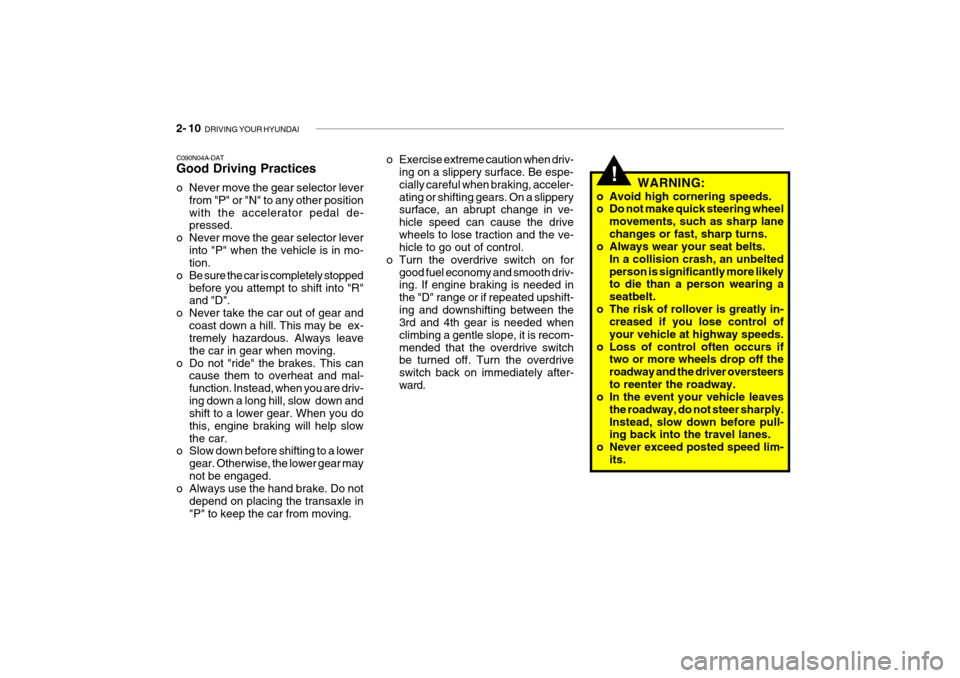
2- 10 DRIVING YOUR HYUNDAI
!
C090N04A-DAT Good Driving Practices
o Never move the gear selector lever
from "P" or "N" to any other position with the accelerator pedal de- pressed.
o Never move the gear selector lever
into "P" when the vehicle is in mo-tion.
o Be sure the car is completely stopped before you attempt to shift into "R"and "D".
o Never take the car out of gear and coast down a hill. This may be ex-tremely hazardous. Always leave the car in gear when moving.
o Do not "ride" the brakes. This can cause them to overheat and mal-function. Instead, when you are driv-ing down a long hill, slow down and shift to a lower gear. When you do this, engine braking will help slowthe car.
o Slow down before shifting to a lower
gear. Otherwise, the lower gear maynot be engaged.
o Always use the hand brake. Do not
depend on placing the transaxle in"P" to keep the car from moving. o Exercise extreme caution when driv-
ing on a slippery surface. Be espe-cially careful when braking, acceler-ating or shifting gears. On a slippery surface, an abrupt change in ve- hicle speed can cause the drivewheels to lose traction and the ve- hicle to go out of control.
o Turn the overdrive switch on for good fuel economy and smooth driv-ing. If engine braking is needed in the "D" range or if repeated upshift-ing and downshifting between the 3rd and 4th gear is needed when climbing a gentle slope, it is recom-mended that the overdrive switch be turned off. Turn the overdrive switch back on immediately after-ward. WARNING:
o Avoid high cornering speeds.
o Do not make quick steering wheel movements, such as sharp lane changes or fast, sharp turns.
o Always wear your seat belts.
In a collision crash, an unbeltedperson is significantly more likely to die than a person wearing a seatbelt.
o The risk of rollover is greatly in- creased if you lose control ofyour vehicle at highway speeds.
o Loss of control often occurs if two or more wheels drop off theroadway and the driver oversteersto reenter the roadway.
o In the event your vehicle leaves
the roadway, do not steer sharply.Instead, slow down before pull- ing back into the travel lanes.
o Never exceed posted speed lim- its.